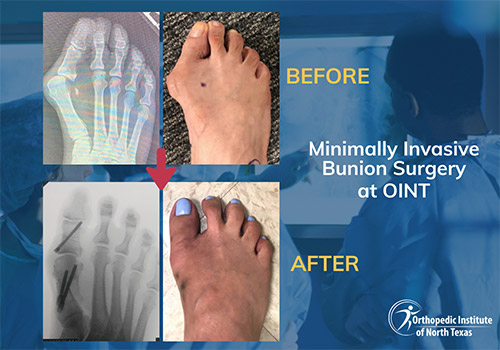Minimally Invasive Bunion Surgery
Traditional bunion surgery involves making an incision exposing the painful bump at the base of the big toe in order to perform cuts in the bone to realign the big toe and first metatarsal. Results are generally favorable with the majority of patients experiencing relief in pain, an easier time with shoewear, and high rates of satisfaction. Unfortunately, recovery after a traditional bunion surgery can take months. Swelling and residual pain can last a prolonged period of time although this generally resolves with most patients back into shoes by twelve weeks.
Previous attempts to minimize incisions were less successful and the procedures from the past were largely abandoned. Over the last decade, there has been a resurgence in the use of minimally invasive techniques to treat bunions. A greater understanding of the deformity associated with a bunion, innovations in implants and instrumentation, and learning from the mistakes of the past have resulted in high patient satisfaction with rapid return to normal activities often times cutting the recovery in half compared to traditional bunion surgery.
What is Minimally Invasive Bunion Surgery?
If you are considering surgery for a painful bunion, a minimally invasive surgery can reliably address the appearance of the foot as well as the pain associated with the deformity.
Using a series of nick incisions (usually around 2mm in length), cuts in the bone can be performed using live x-ray to allow visualization of the surgery without the need for a large incision. The incisions often times don’t require sutures for closure.
Here you can see one of the Minimally Invasive Bunion Surgeries performed by Dr. Justin Kane.
What Can I Expect After Minimally Invasive Bunion Surgery?
Generally, people who have a minimally invasive bunion correction will be allowed to walk the day of surgery. The surgery is performed as an outpatient procedure and patients are often discharged from the hospital in under 3 hours.
At two weeks a postoperative visit will allow your doctor to evaluate your foot. In the majority of people, shoewear can be advanced to regular shoes as pain allows. By six weeks the majority of patients are back to all shoewear and can often participate in low impact exercises such as yoga, pilates, elliptical training, and exercise bike. By twelve weeks many patients are back to higher impact activities such as running, and tennis.
Scars are minimized with this technique and many people cannot even see where the surgery was performed.
Why Minimally Invasive Bunion Surgery with Dr. Justin Kane?
Experience matters. Minimally invasive bunion surgery has a steep learning curve and most physicians who perform bunion surgery have not formally trained in minimally invasive techniques. Dr. Justin Kane trained in Europe with the pioneers of the procedure and has been performing minimally invasive bunion surgery for four years and has performed the most minimally invasive procedures in North Texas. People routinely travel from across the United States to have their bunion surgery performed at the Orthopedic Institute of North Texas.
In comparison to traditional open bunion surgery, one can expect to have an accelerated recovery with many patients walking the same day of surgery. Because there is less injury to the soft tissue, less pain medicine is needed in the early post-operative time period compared with traditional open bunion surgery. By two weeks after the procedure, most patients are back in regular shoes. By six weeks after the procedure, many are back to impact exercise.
Complications associated with minimally invasive bunion surgery do exist however, when compared to traditional open bunion surgery, those complications are drastically reduced. Incision-related complications are minimal given the lack of a large incision necessary to perform the procedure. Stiffness in the joint is less since no dissection around the joint itself is performed. Recurrence of the bunion deformity is also reduced as the correction solely relies on the correction through the bones rather than soft tissue re-balancing.
Before and After Photos of Minimally Invasive Bunion Surgery
This patient presented to the office with years of pain over the inside of the foot. The pain had gotten so severe that for the last four years she had not worn regular shoes. She was only able to wear flip-flops. After surgery, she was walking in a post-operative sandal. At two weeks she was able to transition into a wide toe-box shoe and by six weeks after surgery she was wearing regular shoes again.
For more Before and After photos of Minimally Invasive Bunion Surgery check out our Photo Gallery

